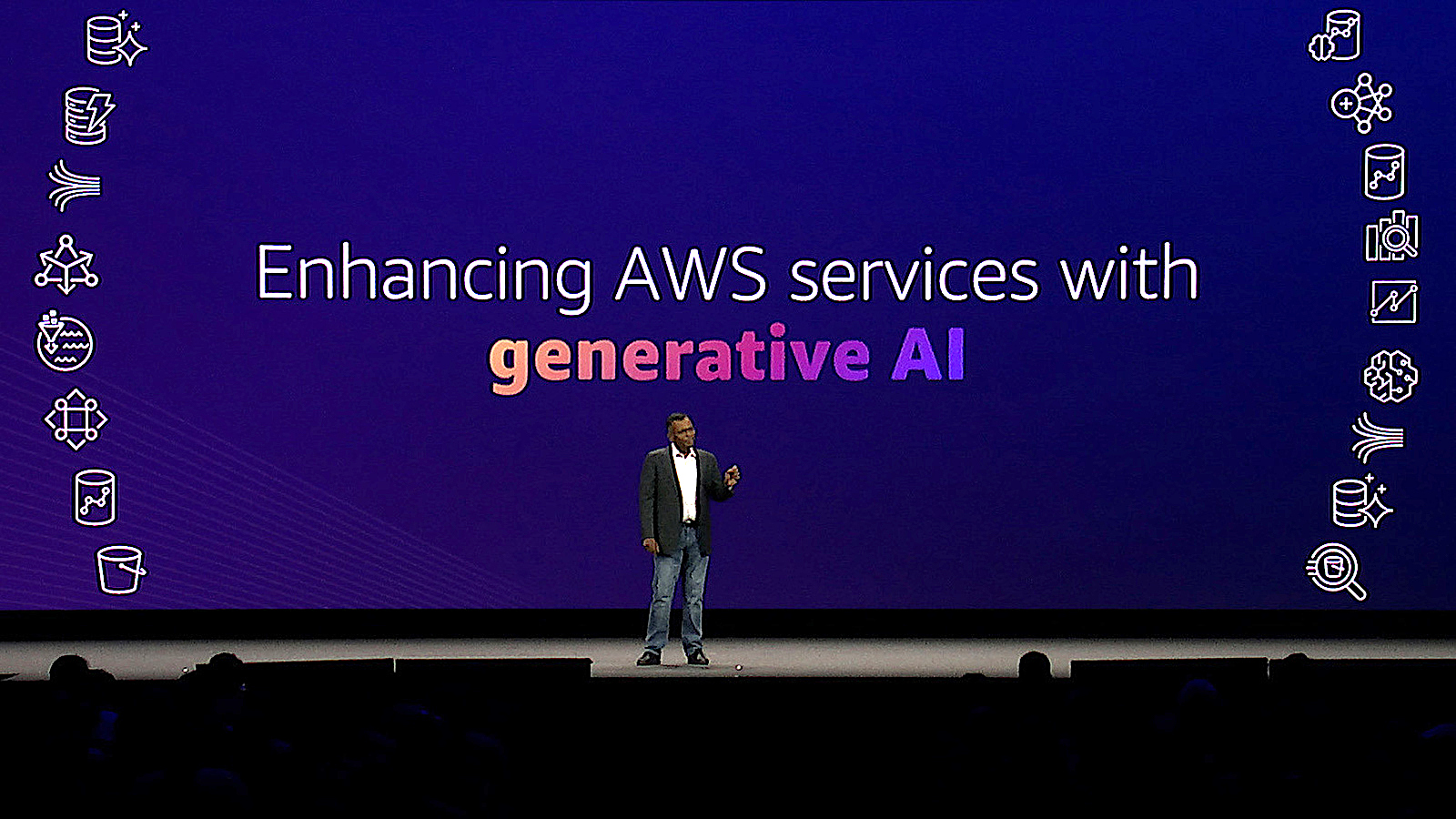 AI
AI
 AI
AI
 AI
AI
Artificial intelligence was the focus this week at Amazon Web Services Inc.’s AWS Summit New York, which makes sense given the massive interest in the topic since ChatGPT was launched.
For example, AWS announced several updates to its managed foundational model service, Amazon Bedrock. This was just one of many announcements that make it easier for customers to deploy generative AI to solve complex problems. Although much of the news was focused on Bedrock and other product releases, there were several underlying themes to the event that were worth recapping.
During his keynote, Swami Sivasubramanian (pictured), vice president of databases, analytics and machine learnings at AWS, called this moment the “tipping point for generative AI.” He mentioned that we are at somewhat of a convergence point where several forces are coming together.
“We have massive amounts of data and the availability of extremely scalable computing infrastructure as well as advancements in machine learning technology allowing generative AI to take shape finally,” he said. He walked through the evolution of AI, where initial use cases of machine learning could take simple inputs and map them to simple outputs, such as predicting outcomes. Deep learning allowed for AI to ingest more complicated data, such as videos and images, and make them into basic outputs.
With generative AI, complex information can be used to generate code, write stories, and create images and videos. Although many businesses might fear generative AI, the reality is that it’s here, and early adopters will experience some bumps along the way but gain a big advantage over those that wait.
The release of ChatGPT is a double-edged sword. On one side, it helps us understand what’s possible and experience AI in a new way. The flip side is that it exposed what can happen with bad data, as many people experience hallucinations, and raised an eyebrow at its effectiveness. In reality, businesses will operate off a much different data set than consumer tools.
Search is a good example. One might use Google to find out what the weather is. However, a meteorologist at the Weather Channel will use its proprietary data set to model what the weather might look like. Similarly, lawyers use Lexis Nexis, and financial analysts use Dow Jones. The business use of generative AI will be based on curated data sets, providing more accurate outputs.
After the keynotes, I had a one-on-one with Ganapathy (G2) Krishnamoorthy, vice president of analytics at AWS, and we discussed this. “Just like search boxes now show up in every application, I would expect to see natural language interactions start showing up in those same applications,” he told me.
Although there were many product announcements, one I liked most was the preview of a new product called AWS Healthscribe. This is a HIPAA-compliant service that automatically creates notes for clinical applications.
One of the challenges with vertically specific transcription and note creation is the tremendous amount of industry jargon. To help with that, AWS includes references to the original transcripts for every sentence in the AI-generated medical notes. Ideally, the note creation would be fully automated, but the reality is, particularly in the early days of generative AI, some manual checking is required. As the models continue to refine, the human oversight required will be reduced.
This should be the first of many industry-specific solutions. During the analyst and press prebriefing, I asked Matt Wood, vice president of product at AWS, what would be next. He declined to answer but did say AWS is looking at many other industries.
There is much fear around AI that it will take people’s jobs. The reality is that it will. Earlier this year, the World Economic Forum released a report predicting that by 2025 AI will replace 85 million jobs and create 97 million more.
The announcement that I felt flew under the radar was that AWS announced seven new training courses on generative AI. These are designed to help people train for future AI and ML jobs. The courses, which are low- to no-cost, are on-demand training videos to help people understand, implement and start working with generative AI.
It’s easy to think of generative AI as a set of tools. Success with generative AI requires a robust infrastructure foundation to support the enterprise’s massive scale, power, security, and reliability needs. This requires the most performant, cost-effective infrastructure that is purpose-built for machine learning.
AWS has made massive investments in its silicon and with partners. In fact, it was 12 years ago that AWS became the first cloud provider to bring Nvidia Corp. graphics processing units to the cloud. Since then, the two companies have had a great partnership and co-delivered GPU-based applications for AI, graphics, gaming and HPC applications.
“Companies have been using these GPU-based instances to speed up ML and to scale their training workloads up to 10,000 GPUs,” Sivasubramanian said during his keynote. “Our customers continue to push the boundaries of these large-scale LLMs as the models get more sophisticated.”
That led to the announcement of Amazon EC2 PF instances. This brings Nvidia H100 Tensor Core GPUs to the cloud, which is silicon optimized for generative AI.
This was an impressive set of generative AI announcements from AWS, but the important thing is that the hyperscaler’s focus is more than just the tools. It has great tools but also the training, cross-product integration, vertical solutions and other aspects needed to help its customers create with generative AI. More is surely to come at the AWS re:Invent conference in November.
Zeus Kerravala is a principal analyst at ZK Research, a division of Kerravala Consulting. He wrote this article for SiliconANGLE.
THANK YOU